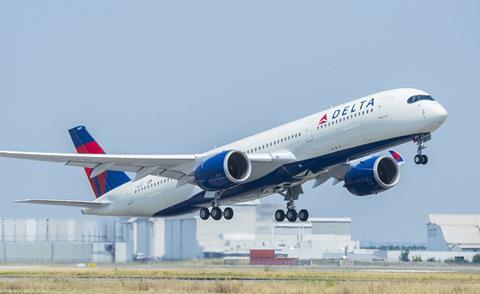Pilot union Air Line Pilots Association, International (ALPA) estimates the cost of upgrading radio altimeters on US commercial aircraft due to possible interference from fifth-generation (5G) cell phone networks will reach into six-figures per aircraft, and could take years to complete.
In a scathing letter to the US House of Representatives subcommittee on aviation, ALPA president Joe De Pete on 8 February blasted the Federal Communications Commission (FCC) - the government agency that regulates telecoms companies - for being negligent and ignoring aviation industry concerns regarding interference with avionics equipment ahead of the introduction of 5G service across the country last month.
The “avoidable crisis” that resulted, he adds, will cost the airlines millions to fix.
“While it is difficult to provide specific information, we are generally aware that avionics upgrades can be more expensive than many would ever imagine,” De Pete writes. “Because multiple radar altimeters are installed aboard large air transport aircraft, the cost of the modified or new equipment, including the cost of labor to install the equipment, and the cost of aircraft time out of service, the overall cost could easily be $100,000-$150,000 per aircraft, depending on the aircraft type.”

ALPA’s letter was in response to a subcommittee hearing in Washington DC last week, during which representatives from the aviation and telecoms industries testified about the botched roll-out of 5G, that prompted the FAA to limit some aircraft operations – including instrument landings – near some airports due to concern that new cellular transmissions in the C-Band may interfere with radio altimeters.
While cell phone companies AT&T and Verizon turned on C-Band transmissions nationwide on 19 January, they agreed to shut off about 500 radio towers near airports with low-visibility approaches as long as the issues persisted, the FAA’s Steve Dickson told the committee on 3 February.
The US regulator has since cleared about 90% of the US commercial aircraft fleet to operate in those 5G areas, though some jets that are cleared still face operating restrictions.
In response to the possible safety hazards created by the 5G towers, the FAA has started developing new radio altimeter standards for aircraft, which could take a year or more. Some existing altimeters may end up being compliant, but others will not and need to be replaced, Dickson told the committee last week.
That has left many in the aviation industry angry that the safety of aircraft in these environments were not taken into account earlier. De Pete criticized the FCC, claiming that the commission withheld information, and did not consult with aviation authorities until shortly before the towers were to be turned on.
“Given that the agency legally tasked with oversight of the telecommunications industry completely failed to provide critical information relevant to the safety of the US airspace system and voluntary dialogue by private sector companies did not begin until the precise time their actions posed catastrophic harm to public safety, it is clear there is a systemic failure of governance over the wireless industry’s use of spectrum, disclosure of information, and licensing,” De Pete writes.
“This necessitates a redesign of the government’s authority over these providers, including granting affected agencies, like the FAA, authority to reject or modify new or expanded spectrum applications as well as the ability to directly interact with the FCC,” he adds. “The hearing provided damning insight into how broken the federal radio spectrum and licensing process is in relation to aviation safety and the need for immediate reform.”
ALPA says that even if the FAA publishes new standards in the next 12 months, it could take much longer until the industry has eliminated the safety risk completely.
“Once new altimeter standards are available, the timeline for design, testing, certification, manufacturing, and installation is likely to take four or more years, even with priority placed on these upgrades,” De Pete says. ”There may also be additional unforeseen costs to accelerate the process and upgrade all airliners, including those operated by international airlines operating in US airspace. This truly is a global problem.”
The FAA’s Dickson said that the aviation industry had raised concerns as early as 2015, adding that the FAA lacked cellular data needed to evaluate risk, and that the aviation and cellular industries only began collaborating effectively last December, just weeks before the cell phone networks were scheduled to be launched.


























